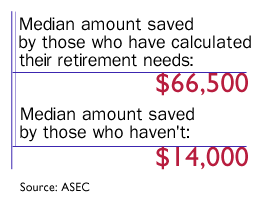NEW YORK (CNNfn) - Getting old isn't what it used to be -- at least when it comes to collecting Social Security.
News that the retirement age is increasing this year from 65 to up to 67, depending on your age, has taken most Americans by surprise. But it has been a matter of law for years.
In 1983, citing greater life expectancies, Congress approved an age increase to prevent shortfalls in the Social Security system.
For anyone born after 1937, the change means you should reconsider how much you'll need to save to ensure a comfortable retirement, since you may lose up to two years of payouts.
"This is a wake-up call," said Dallas L. Salisbury, president of the Employee Benefit Research Institute (EBRI), a nonprofit organization that studies employee benefits issues.
'Focus on income replacement'
Under the new requirements, a 51-year-old worker will be eligible for full benefits at 66, which means he would have to save an additional $10,000 to $15,000 to compensate for the extra year of lost benefits, according to Don Blandin, president of the American Savings Education Council (ASEC).

"It's a lot of money (when) you add it on to what (he's) already trying to achieve," Blandin said. "(People) need to focus on income replacement."
The same goes if you want to take early retirement at 62. You'll still be able to take the reduced early retirement benefit. But since the gap between early and full retirement is increasing, your benefit will be less than the standard 80 percent people have received in the past.
Take a hard look at the numbers
If you haven't received one already, check your mailbox for a statement from the Social Security Administration within a few months of your next birthday. It will detail your earnings to date and estimate your benefits at retirement.
But keep in mind the numbers are only estimates. Blandin said you should figure Social Security payments will cover between 23 percent and 43 percent of your pre-retirement income, as the law stands now. The higher your earnings, the lower the percentage.

Ken Stern, president of Asset Planning Solutions and author of Senior Savvy, is less optimistic. He estimates Social Security will replace no more than 20 percent of the average paycheck.
Either way, plan to pony up the bulk of your retirement money. The best way to do that, Stern said, is to stay longer in stocks than traditional wisdom suggests.
'Your money can never retire'
If you need $50,000 a year when you retire 20 years from now, you should plan to have $83,000 a year in the bank, which accounts for an annual inflation rate of 3.5 percent, Stern said. And that means you will have to save nearly $1 million to last you 10 years in retirement.
You should be able to save that much through stocks, pensions and private savings, and consider Social Security "pocket change," Stern said.

When deciding how much exposure you should have in stocks, don't stick to the old asset-allocation formula where you subtract your age from 100 to figure out how much you should keep in equities, Stern said. Just be sure to choose more conservative stocks as you get older.
Certified financial planner Barbara Steinmetz is a fan of equity investing throughout your retirement years, especially in diversified mutual funds.
"I don't care when you retire. Your money can never retire," Steinmetz, a Financial Planning Association member, said.
Depending on the size of their portfolios, she recommends 70-year-olds who can stomach moderate risk keep two years of living expenses in an interest bearing account, 50 percent of their remaining assets in bonds and 50 percent in stocks.
If you are decades away from retirement, "do things that are tax-deferred," Steinmetz said. "Max the 401(k) or 403(b) -- that's a no-brainer."
Brace for more changes
Adopting a self-reliant attitude towards savings is just as important as picking a diversified stock portfolio. It will help you weather any future -- and potentially more drastic -- changes in Social Security.
"We need to do a lot more saving and investing on our own," Stern said.
After all, there is no guarantee the retirement age will not go up again before you hit your mid-60s, experts say. Indeed, some say it must rise in order to keep the Social Security system viable.
Let's face it, Steinmetz said. "It's not your Mom and Dad's retirement anymore." 
|

